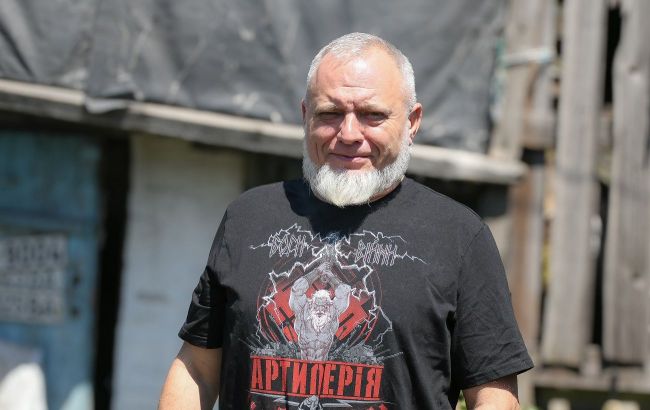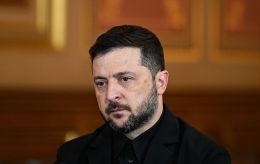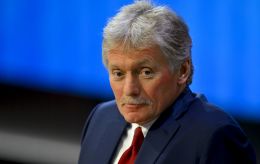Russians are killing their own: How artillerymen of Ukraine's 32nd Brigade fight near Pokrovsk
 Commander of the 32nd Artillery Division of the Separate Mechanized Brigade Steel of the Armed Forces of Ukraine with call sign Sailor (photo: RBC-Ukraine/Anastasiia Rokytna)
Commander of the 32nd Artillery Division of the Separate Mechanized Brigade Steel of the Armed Forces of Ukraine with call sign Sailor (photo: RBC-Ukraine/Anastasiia Rokytna)
The Pokrovsk sector remains one of the toughest on the frontline. The artillerymen of the 32nd Separate Mechanized Brigade Steel of the Armed Forces of Ukraine are holding back the enemy here together with other units. RBC-Ukraine visited the soldiers' positions and spoke with the division commander, with the call sign Sailor.
On a hot summer morning, we set off along a lonely road near Pokrovsk. The road leads straight into the city, which today dominates the headlines from the front. We bypass FPV threats that have been tailing us since the Kramatorsk-Dobropillia highway. Sitting in front is the 50-year-old commander of the artillery division of the 32nd Separate Mechanized Brigade Steel, call sign Sailor. Short in stature, with a gray beard and a direct gaze.
The artillery division of this brigade was created from scratch just two years ago. Before that, Sailor was the commander of a mortar battery. The first weapon they received was nicknamed among the troops the “Death Star.” These were D-44 guns, developed back in 1942.
Despite their small caliber, the unit successfully hit the enemy in the Kupiansk sector, repelling assaults and disrupting the Russian logistics. Now the division has received American M109 Paladin self-propelled howitzers - more accurate and practical.
As we move closer to the artillery positions, the commander talks about the peculiarities of the Pokrovsk sector, stories of eliminated “legendary” Russian guides, and the cruelty of the enemy even toward their own comrades.
– How do you protect your equipment from Russian kamikaze drones?
– Reinforcement with steel plating helps a bit, because when a cumulative shell flies in, it hits the armor first.
– So, because of this plating, the enemy needs more FPVs to destroy your equipment?
– Exactly. The Russians used 15 FPVs to hit one of our vehicles. Then we evacuated it. Repaired it. Basically, now it’s back in service.
– When did you first face such a massive use of FPVs by the enemy?
– In 2022, no one had even heard of FPVs. In 2023, in Bakhmut and Chasiv Yar – still nothing. I learned about Lancets (Russian drone – ed.) when we entered the Kharkiv sector, that’s where I first saw them in large numbers. Now, there are just huge amounts.
 Sailor, commander of the artillery division (photo: RBC-Ukraine / Anastasia Rokytna)
Sailor, commander of the artillery division (photo: RBC-Ukraine / Anastasia Rokytna)
I recently watched an interview with Madyar (Commander of Ukraine’s Unmanned Systems Forces - ed.). He said a very accurate phrase: “Soon neither we nor they will be able to move anywhere,” precisely because of the massive number of FPVs dominating the skies. Even now, mortar units carry munitions by hand. For kilometers. Those mines are far from light.
– What about electronic warfare? Does it help against FPV raids?
– Very low frequencies, no. The Russians keep changing them, lowering and raising. For example, if we see an FPV flying right past us, we don’t touch it. If it’s going in for a strike – we shoot it down. If it’s just flying and watching – leave it. Let it fly.
– What have you managed to hit recently?
– Guns, mortars. Here in this sector, there was this Russian soldier with the call sign Arnold. He spent a week trying to reach us. Tried to run into our shell (laughs – ed.).
He was a guide, leading Russian groups into Pokrovsk for the past week and a half. They try to sneak in by twos and threes across the fields. They have checkpoints they must reach. Many made it, many did not. Arnold was the one guiding them – he knew the terrain and maps. He made it closer to Pokrovsk, lingered, but couldn’t dig in.
– Compared to other sectors, are there more enemy troops here?
– In this sector, yes, many. In the first three months, we struck about 700 of them. Both killed and wounded. That’s just what’s officially confirmed.
Earlier, the forward line was just the forward line. You entered and fought there. Now there are 10 kilometers between their forward line and ours – that’s the route they must walk. So Russians march from Novotroitske (settlement in the Kherson region – ed.) and walk 10 kilometers on foot. We see them all along the way and try to destroy them. The “gray zone” is practically controlled by the enemy – being there is impossible.
– Were there any strikes after which you thought “Wow”?
– There was a case in Toretsk. An apartment building. We destroyed the first floor. The basement survived. The Russians gathered there and from there launched assaults on our positions. It didn’t last long. With a double strike, we finished it. Later, through intercepted comms, we heard how badly it hit them.
We’re brigade artillery. There are separate artillery brigades working on long-range targets. Our job is to strike the frontline – troops and equipment. Recently, at night, a Russian gun was moving. Drone pilots spotted it, we hit it, and finished it off.
 The road leads straight into Pokrovsk – a city dominating today’s frontline reports (photo: RBC-Ukraine / Anastasiia Rokytna)
The road leads straight into Pokrovsk – a city dominating today’s frontline reports (photo: RBC-Ukraine / Anastasiia Rokytna)
– What’s the Russian tactic in the Pokrovsk sector?
– The specifics have changed. In Kupiansk, they attacked with massive numbers of troops. There was one epic assault when 10 of them with RPGs just walked out into the open field. So casual and confident, that of course, they were quickly spotted and taken out. Another case: 26 Russians came out of the industrial zone, marching in column, waving the Russian flag, right across the field. We eliminated them, too.
Now they no longer move in groups, but in twos. No more clusters of 15 men. Artillery now works against these small targets. Harder to find, but we do. They have a dugout in a forest strip, but launch Maviks (teleoperated compact quadcopter drone - ed.) 600 meters from it, making the position harder to locate. Still, we’ve hit them – directly into the dugout.
– So they reduced group sizes because they want to save manpower?
– Hard to say. In the Dragon forest strip, there was a whole company of Russians. There was a trail. On Telegram, we found a video: one of their soldiers walking along it, filming. Around him – corpses. He just walked past, filming them.
They don’t retreat. Perhaps blocking detachments are behind them. In intercepted comms, we often hear: “No going back, only forward.” We had one case – at the edge of a field, we wounded a Russian. He crawled on his knees across the field. For some reason, he didn’t want to go back to his own.
The brigade that previously held the Pokrovsk sector was probably the only one that evacuated wounded and even collected bodies. They weren’t too happy about it – they cursed, shouted at the wounded, even kicked one who couldn’t walk. But still, they came, tried to evacuate.
Most Russians, though, just don’t care. Just yesterday, one stepped on a mine. Three others walked up, looked, said something like “Sorry, man, we’re moving on,” and left.
We also saw on streams – one of theirs walked past where we had hit them. A wounded soldier among the dead raised his hand, asking to be saved. The other just shot him and kept walking. That’s their version of “We don’t abandon our own.”
According to Sailor, the Russians cling so desperately to the Pokrovsk sector because it’s their gateway to open space. If they break through here, they can advance toward Kostiantynivka and Kramatorsk. As the commander, who has seen battles in different areas of the front, says, this is one of the hardest directions.
 The artillerymen of the 32nd Separate Mechanized Brigade Stee hold back the enemy alongside other units (photo: RBC-Ukraine / Anastasia Rokytna)
The artillerymen of the 32nd Separate Mechanized Brigade Stee hold back the enemy alongside other units (photo: RBC-Ukraine / Anastasia Rokytna)
Meanwhile, we rush along an empty, silent road. The silence itself is alarming, as air threats are constant nearby. The speedometer breaks civilian limits – only the laws of war and survival apply here. As the enemy tries to encircle Pokrovsk and Myrnohrad, we reach the artillery positions. A drone could be anywhere. We jump out quickly and sprint to the dugouts before we’re spotted from above.
Recruiting posters create an idealized image of a fighter: tactical, tall, muscles bulging under a tight T-shirt. But in the dugout of an artillery crew, things look very different.
In front of me, men with cracked hands, covered in dust, fatigue burned into their eyes. Not gym-goers. Here, abs don’t matter – endurance does. Constant physical labor replaces the gym: carrying dozens of kilos, such as shells, concrete slabs, shovels, and fortifications. All fueled by instant noodles, packet coffee, and energy bars.
Sailor heads straight to his men to discuss the situation. I walked into the dugout. A mouse sneaks ahead of me, into the darkness – happy to have found its own “edible El Dorado” in the middle of a field. In these walls, it is as permanent as the dull sound of explosions outside. Just like these men, silent, exhausted, precise. They won’t end up on posters. But they are the ones keeping the skies above the soldiers in the trenches.
 Soldier with the call sign Sparrow handles the maintenance of the gun (photo: RBC-Ukraine / Anastasiia Rokytna)
Soldier with the call sign Sparrow handles the maintenance of the gun (photo: RBC-Ukraine / Anastasiia Rokytna)
I meet a fighter with the call sign Sparrow. He’s responsible for maintaining the gun: preparing it for firing, checking its condition, and overseeing its readiness for action. Originally from Kyiv, but the war brought him here, to Pokrovsk.
“At first, when you get to the position, it feels unbearably hard. But then you get used to it. Mentally it’s easier, but physically… it stays hard,” he says, adjusting his cap.
FPV drones are much more numerous now. Four strikes in a row hit their comrades’ positions – the sound reached even here. This morning, one struck near them, too.
“Before, we kept shells right by the gun to speed up the fire. Now we hide them. Because those ‘birds’ are everywhere. They strike more accurately than we’d like,” Sparrow adds.
The position is well hidden. Camouflage is so dense that equipment is hard to spot from afar. But the main thing here is rhythm – an endless cycle:
– Load! Fire out! Shot!
And again. No questions. No “aren’t you tired, guys?”
The crew is mostly older men. Some already have grandchildren. Only one stands out – the 21-year-old gunner Maksym. He came to artillery from the marines. His military-style T-shirt is probably the only thing that sets him apart in the crew. He speaks little. Conversation is rare here. But he says work is “fine.” War erases age differences; here, everyone is equal.
Sailor praises the young man. He’s glad to have such soldiers in his division. It’s important to him that the men feel connected to their commander, so he visits them, bringing volunteer treats on holidays. He knows the men are exhausted – motivation alone isn’t enough anymore.
“The biggest problem is the lack of manpower and drones. If we had at least twice as many drone operators, not a single occupier would pass. We’d crush them. The more operators, the more drops,” Sailor says as we drive away from the positions.
He’s frustrated with civilians’ attitude toward military recruitment centers, because he sees firsthand how infantry, pilots, and commanders are bogged down in endless frontline rotations. A year ago, rotation was needed for rest. Today, it’s simply that there aren’t enough men. For Sailor, the only source of motivation is his family, which is why, even at 50, he continues to serve.








The artillerymen of the 32nd Separate Mechanized Brigade Steel of the Armed Forces of Ukraine defend Ukrainian positions near Pokrovsk (photo: RBC-Ukraine / Anastasia Rokytna)

